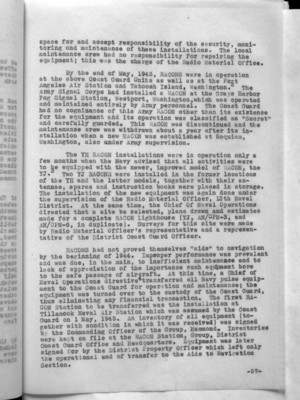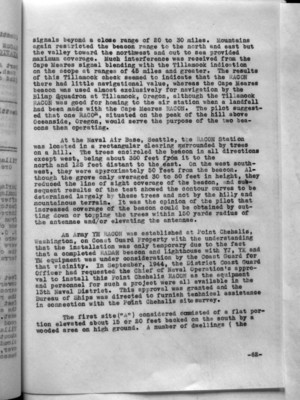Pages That Mention YH RACON
Coast Guard District narrative histories 1945
77
space for and accept responsibility of the security, monitoring and maintenance of these installations. The local maintenance crew had no responsibility for repairing the equipment; this was the charge of the Radio Material Office.
By the end of May, 1943, RACONS were in operation at the above Coast Guard Units as well as at the Port Angeles Air Station and Tatoosh Island, Washington. The Army Signal Corps had installed a RACON at the Grays Harbor Fog Signal Station, Westport, Washington, which was operated and maintained entirely by Army personnel. The Coast Guard had no cognizance of this Army RACON other than its existence for the equipment and its operation was classified as "Secret" and carefully guarded. This RACON was discontinued and the maintenance crew was withdrawn about a year after its installation when a new RACON was established at Hoquiam, Washington, also under Army supervision.
The YH RACON installations were in operation only a few months when the Navy advised that all activities were to be equipped with the newer, improved model of RACON, the YJ.³ Two YJ RACONS were installed in the former locations of the YH and the latter models, together with their antennae, spares and instruction books were placed in storage. The installation of the new equipment was again done under the supervision of the Radio Material Officer, 13th Naval District. At the same time, the Chief Of Naval Operations directed that a site be selected, plans drawn and estimates made for a complete RACON Lighthouse (YJ, AN/CPN-3, and AN/CPN-6, in duplicate). Surveys for this site were made by Radio Material Officer's representative and a representative of the District Coast Guard Officer.
RACONS had not proved themselves "aids" to navigation by the beginning of 1944. Improper performance was prevalent and was due, in the main, to inefficient maintenance and to lack of appreciation of the importance such equipment bore to the safe passage of aircraft. At this time, a Chief of Naval Operations directive^4 transferred all Navy pulse equipment to the Coast Guard for operation and maintenance; the equipment was turned over to the custody of the Coast Guard, thus eliminating any financial transaction. The first RACON Station to be transferred was the installation at Tillamook Naval Air Station which was assumed by the Coast Guard on 1 May, 1945. An inventory of all equipment (together with condition in which it was received) was signed by the Commanding Officer of the Group, Hammond. Inventories were kept on file at the RACON Station, Group, District Coast Guard Office and Headquarters. Equipment was later signed for by the District Property Officer which left only the operational end of transfer to the Aids to Navigation Section.
-57-
82
signals beyond a close range of 20 to 30 miles. Mountains again restricted the beacon range to the north and east but the valley toward the northwest and out to sea provided maximum coverage. Much interference was received from the Cape Meares signal blending with the Tillamook indication on the scope at ranges of 45 miles and greater. The results of this Tillamook check seemed to indicate that the RACON there had little navigational value, whereas the Cape Meares beacon was used almost exclusively for navigation by the Blimp Squadron at Tillamook, Oregon, although the Tillamook RACON was good for homing to the air station when a landfall had been made with the Cape Meares RACON. The pilot suggested that one RACON, situated on the peak of the hill above Oceanside, Oregon, would serve the purpose of the two beacons then operating.
At the Naval Air Base, Seattle, the RACON Station was located in a rectangular clearing surrounded by trees on a hill. The trees encircled the beacon in all directions except west, being about 350 feet from it to the north and 125 feet distant to the east. On the west south-west, they were approximately 50 feet from the beacon. Although the grove only averaged 30 to 50 feet in height, they reduced the line of sight coverage of the beacon, and subsequently results of the test showed the contour curves to be determined largely by these trees and not by the hilly and mountainous terrain. It was the opinion of the pilot that increased coverage of the beacon could be obtained by cutting down or topping the trees within 150 yards radius of the antennae and/or elevating the antennae.
An Army YH RACON was established at Point Chehalis, Washington, on Coast Guard Property with the understanding that the installation was only temporary due to the fact that a completed RADAR beacon and Lighthouse with YJ, YK and YM equipment was under consideration by the Coast Guard for that vicinity. In September, 1944, the District Coast Guard Officer had requested the Chief of Naval Operation's approval to install this Point Chehalis RACON as the equipment and personnel for such a project were all available in the 13th Naval District. This approval was granted and the Bureau of Ships was directed to furnish technical assistance in connection with the Point Chehalis site survey.
The first site ("A") considered consisted of a flat portion elevated about 15 or 20 feet backed on the south by a wooded area on high ground. A number of dwellings ( the
-62-

